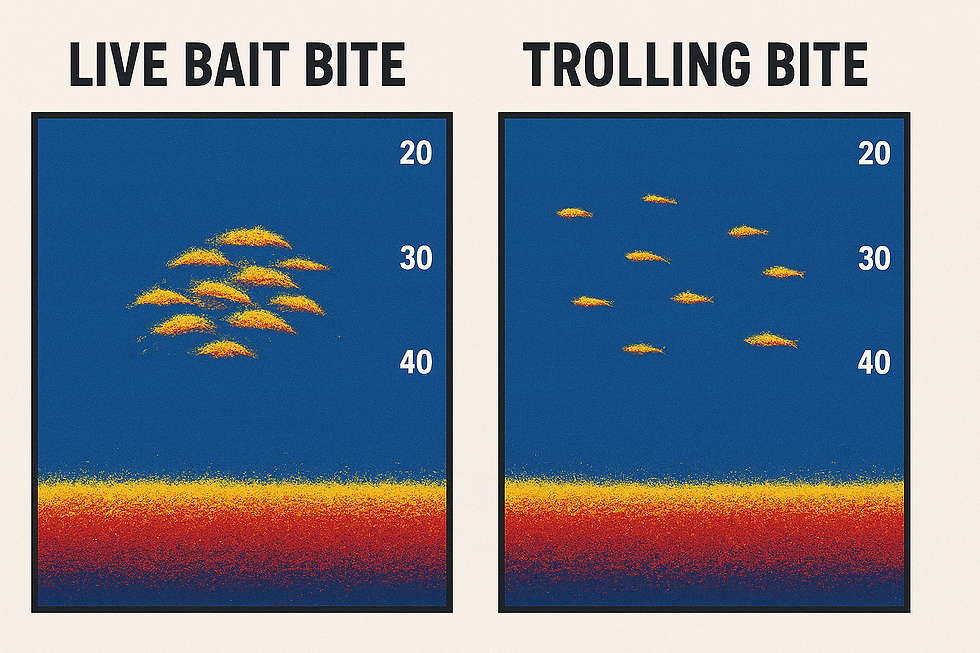Reading the Signs: When to Switch from Live Bait to Trolling for Stripers on Lake Buchanan in Late Summer
- captaindiesel
- Aug 11
- 3 min read
Late summer on Lake Buchanan can be one of the most rewarding — and most puzzling — times of year for striper fishermen. The heat, changing thermocline, and shifting bait patterns force the stripers to adjust their feeding behavior. For those running sonar, the trick is recognizing the subtle signs that the live bait bite is dying and it’s time to break out the trolling rigs.
Understanding the Seasonal Shift
By late August and early September, water temps push into the high 80s. The stripers start to suspend deeper to stay comfortable, often stacking around the thermocline where oxygen levels and temperatures are more stable. Early in the morning, they might chase shad aggressively, making live bait deadly. But as the sun climbs, their feeding windows tighten — and the way they show up on sonar changes.
How Stripers Look on Sonar During the Live Bait Bite
When stripers are actively feeding on live bait:
Returns are tight and aggressive: You’ll see strong, thick arches (or lines, depending on your sonar scroll speed) grouped tightly together.
Vertical movement: Fish will rise in the column toward your bait, showing upward streaks on the screen.
Concentration near structure or bait clouds: Look for them hugging humps, points, or sitting just above shad schools.
Clustered schools: The marks are dense, often 5–15 fish in a group, hovering in one small section of the screen.
This is when downlines and freelines with live shad are deadly — the fish are keyed in on slow, natural presentations.
How Stripers Look on Sonar When It’s Time to Troll
As the live bait bite fades:
Fish spread out horizontally: Instead of tight pods, you’ll see single marks or small loose groups scattered across the screen.
Steady depth bands: The marks often hold in a horizontal “layer” 20–35 feet down without much vertical movement toward bait.
More suspended over open water: You’ll find them off structure, following bait balls mid-lake or between deep points.
Longer gaps between encounters: When moving slowly with live bait, you’ll go minutes without marking active fish — a sign they’re not schooling aggressively in one spot.
This scattered pattern tells you the stripers are cruising and less likely to chase stationary bait, making trolling the better choice to cover ground.
The Transition Period
Sometimes the change is gradual, and you’ll notice both patterns in a single trip:
Morning: Tight marks and vertical movement = stick with live bait.
Midday: Fish spread out, marks get lazier = switch to trolling.
Afternoon: Deep suspensions 30–40 feet over open water = trolling with downriggers or weighted umbrella rigs wins.
Trolling Setup for Late Summer Buchanan Stripers
Lures: 4–6” swim shads, bucktails, or umbrella rigs imitating shad.
Speed: 2.5–3.2 mph to trigger reaction strikes.
Depth Control: Use downriggers, lead-core, or weighted rigs to keep baits in the strike zone where you’re marking fish.
Spread: Run multiple rods at varying depths to cover different parts of the water column.
Final Tip
Your sonar isn’t just a fish finder — it’s a behavior detector. By paying attention to how stripers are positioned and moving, you’ll know when it’s time to switch gears. On Lake Buchanan in late summer, the rule is simple:
Tight and vertical = live bait.
Loose and horizontal = trolling.
Read the screen, adjust your method, and you’ll keep putting fish in the boat even when the summer heat sets in.


Comments